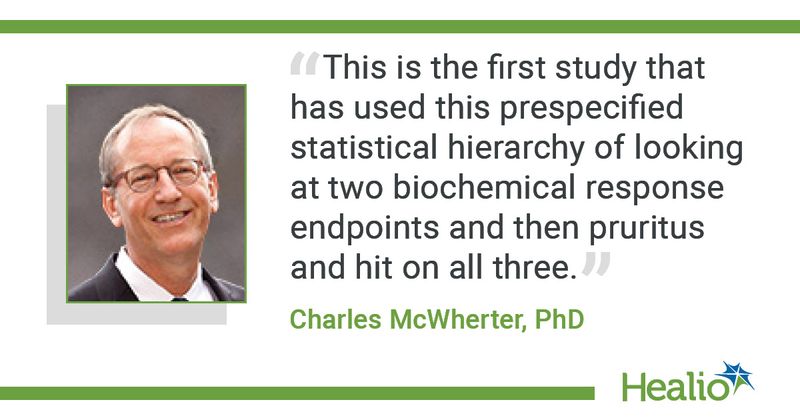Q&A: ‘Normalization’ of biochemical markers in PBC may be possible with seladelpar
After 3 months of treatment, seladelpar significantly improved pruritus and markers of liver injury compared with placebo in patients with primary biliary cholangitis, CymaBay Therapeutics recently announced.
According to a company press release, the phase 3 ENHANCE trial assessed the efficacy and safety of seladelpar (CymaBay Therapeutics), an orally active peroxisome proliferator-activated receptor delta agonist, or delpar, in patients with primary biliary cholangitis. The study enrolled patients who were inadequate responders or intolerant to first-line treatment and randomly assigned them to oral daily seladelpar 5 mg (n = 56) or 10 mg (n = 55) or placebo (n = 56).

The primary endpoint was composite response rate of alkaline phosphatase and bilirubin, while secondary endpoints included alkaline phosphatase normalization and pruritus assessed with the daily pruritus numerical rating scale. Researchers assessed all prespecified endpoints after 3 months.
“This is the first study that has used this prespecified statistical hierarchy of looking at two biochemical response endpoints and then pruritus and hit on all three,” Charles McWherter, PhD, chief scientific officer at CymaBay Therapeutics, told Healio. “We are really excited about that because if we can confirm that in the ongoing RESPONSE study, we think we will have a good chance of offering a new therapy that is distinguished in terms of meeting both disease activity as well as symptoms.”
McWherter spoke with Healio about results from the ENHANCE trial as well as next steps in research of seladelpar.
What was the purpose of the study?
McWherter: The ENHANCE study was intended to look at both biochemical responses, specifically laboratory parameters that are thought to be prognostic for disease progression such as alkaline phosphatase and bilirubin, and assessed improvement in symptoms of pruritus using an electronic diary in which patients every day self-reported daily levels of itch for 3 months or more. We included patients with and without cirrhosis.
Approximately 90% of PBC patients are women. There are vexing, debilitating symptoms of fatigue and especially pruritus, which can be incessant itching and deprive patients of sleep and make them miserable.
Social anxiety and depression are associated with PBC as well because it is hard for patients to participate in daily life and explain to their families, friends and coworkers what they are dealing with. It is not something that is easily understood.
What were some of the key results of the study?
McWherter: We saw that up to 78% of patients taking the 10 mg dose achieved a composite response, which has been associated with improvement in outcomes looking at large epidemiological databases of people living with PBC while taking ursodeoxycholic acid. Normalized alkaline phosphatase levels were seen in nearly one out of three patients treated with seladelpar, compared with none of the patients in the placebo group achieving normal alkaline phosphatase values.
In patients with clinically significant itch at baseline, which was established with a numerical rating scale of 0 to 10, where 4 or greater is moderate to severe, there was a statistically significant decrease from approximately 6 to less than 3 with the seladelpar 10 mg dose vs. about a one-and-a-half-point decrease with placebo.
We also saw improvement in the composite response of liver laboratory measures that are associated with disease, including alkaline phosphatase and bilirubin as well as normalization of alkaline phosphatase. If this key feature is confirmed for seladelpar, that would mean this is a drug that could actually lead to normal liver lab results for many patients.
What was the main takeaway of the study?
McWherter: We saw improvements in markers of cholestasis, reductions in markers of liver injury and improvement in symptoms. The seladelpar profile appeared to be generally safe and well-tolerated in the study. The field needs something that can improve disease activity symptoms and do it across a broad stage of disease, including in patients with cirrhosis.
How will the results inform patient care?
McWherter: This is something that we have been actively trying to communicate with and gather feedback from the medical community, but our view is that the field is going to trend toward now having agents that could potentially normalize liver biochemistry, as well as treat symptoms. There is nothing approved for treating symptoms in patients with PBC.
What are the next steps in research?
McWherter: We have an ongoing, fully enrolled phase 3 study called RESPONSE, with results expected in the third quarter of this year. It is a global study in more than 25 countries on five continents, fully enrolled with 193 patients. The goal of the study is to look at the same endpoints as the ENHANCE trial at 12 months.
If we confirm at 12 months what we saw at 3 months, I think it will put us in a good position to have an agent that would convince regulators, medical experts and, most importantly, physicians and patients that they would have a treatment that could address their needs. If favorable, it would then be submitted to the FDA, hopefully by the first part of next year.
We also have a long-term, phase 3 safety study called ASSURE, which is ongoing in more than 20 countries. Currently, across both the RESPONSE and ASSURE studies we have more than 300 patients taking seladelpar every day.
Reference:
- CymaBay Therapeutics announces publication of results from the ENHANCE, phase 3 study of seladelpar in patients with primary biliary cholangitis (PBC). https://ir.cymabay.com/press-releases/detail/558/cymabay-therapeutics-announces-publication-of-results-from-the-enhance-phase-3-study-of-seladelpar-in-patients-with-primary-biliary-cholangitis-pbc. Published April 21, 2023. Accessed June 21, 2023.
